Celebrating Galungan and Kuningan Day in Bali: A Guide to Bali's Most Vibrant Traditions
Bali is renowned for its rich culture, and two of the most significant celebrations on the island are Galungan and Kuningan Day. These traditional Balinese Hindu holidays bring a special energy and atmosphere to the island, making it a fascinating time to experience the local culture.
What is Galungan Day?
Galungan Day is one of the most important holidays in Bali, symbolizing the victory of good (Dharma) over evil (Adharma). It’s a time when the Balinese believe that ancestral spirits return to Earth, and offerings are made to honor them. This festival occurs every 210 days, based on the Balinese pawukon calendar.
During Galungan, you’ll notice the streets of Bali adorned with tall, beautifully decorated bamboo poles called penjor. These penjor symbolize prosperity and are placed outside homes, temples, and businesses. The poles are decorated with coconut leaves, flowers, fruits, and even traditional snacks, representing offerings to the gods.
What Happens During Galungan?
Families gather to perform rituals, make offerings, and pray in temples. The day is filled with traditional dances, ceremonies, and a variety of delicious Balinese food. One of the key activities is preparing offerings made of fruit, rice cakes, and flowers, which are placed at family shrines and temples.
The preparations begin several days before Galungan, with families creating beautifully arranged offerings and cleaning their homes to welcome the visiting spirits. On Galungan Day itself, you’ll see Balinese people dressed in their finest traditional attire, visiting temples, and spending quality time with loved ones.
What is Kuningan Day?
Kuningan Day marks the end of the Galungan celebrations and takes place 10 days after Galungan. It’s believed that on Kuningan Day, the spirits return to their heavenly abode. The name "Kuningan" comes from the yellow turmeric rice used in offerings, which symbolizes prosperity and gratitude.
On Kuningan Day, the Balinese prepare special offerings made of yellow rice, cooked meats, fruits, and flowers. Temples and homes are decorated with yellow parasols and cloth, representing purity and a connection to the divine. Families once again gather to pray, make offerings, and honor their ancestors before their spirits depart.
During Galungan and Kuningan, Bali becomes a vibrant and festive place. The streets are lined with penjor swaying in the breeze, and the air is filled with the scent of incense. Temples are more active than usual, with families coming together to pray and celebrate. The atmosphere is joyful, spiritual, and colorful, offering a unique insight into the island’s culture.
If you're visiting Bali during Galungan and Kuningan, be prepared to witness a beautiful blend of tradition, devotion, and celebration. It’s an unforgettable experience that showcases the heart and soul of Balinese culture.


